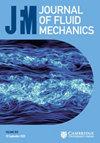壁温对高超音速冲击波/湍流边界层相互作用的影响
IF 3.6
2区 工程技术
Q1 MECHANICS
引用次数: 0
摘要
壁温对冲击波/湍流边界层相互作用(STBLIs)有显著影响,已成为高超音速飞行器设计过程中不可忽视的因素。本文进行了直接数值模拟,以研究在马赫数为 6 的 34° 压缩斜坡上壁温对 STBLI 的影响。模拟中考虑了三种壁温与回收温度比值(0.50、0.75 和 1.0)。结果表明,分离气泡的大小随着壁面温度的降低而显著减小。这是因为随着壁面冷却,边界层的动量剖面变得更饱满,这意味着近壁流体有更大的动量来抑制流动分离。我们提出了一个基于自由相互作用理论的方程,用于预测不同壁面温度下转角上游的壁面压力分布。预测结果与模拟结果基本一致(雷诺数 Reτ 在 160 到 675 之间)。此外,还通过壁面压力的加权功率谱密度和上下游之间的相关性研究了低频不稳定性。结果表明,分离冲击的低频运动主要由下游机制驱动,壁面冷却可以显著抑制低频不稳定性,包括低频运动的强度和流向范围。本文章由计算机程序翻译,如有差异,请以英文原文为准。
Effects of wall temperature on hypersonic shock wave/turbulent boundary layer interactions
Wall temperature has a significant effect on shock wave/turbulent boundary layer interactions (STBLIs) and has become a non-negligible factor in the design process of hypersonic vehicles. In this paper, direct numerical simulations are conducted to investigate the wall temperature effects on STBLIs over a 34° compression ramp at Mach number 6. Three values of the wall-to-recovery-temperature ratio (0.50, 0.75 and 1.0) are considered in the simulations. The results show that the size of the separation bubble declines significantly as the wall temperature decreases. This is because the momentum profile of the boundary layer becomes fuller with wall cooling, which means the near-wall fluid has a greater momentum to suppress flow separation. An equation based on the free-interaction theory is proposed to predict the distributions of the wall pressure upstream of the corner at different wall temperatures. The prediction results are generally consistent with the simulation results (Reynolds number Reτ ranges from 160 to 675). In addition, the low-frequency unsteadiness is studied through the weighted power spectral density of the wall pressure and the correlation between the upstream and downstream. The results indicate that the low-frequency motion of the separation shock is mainly driven by the downstream mechanism and that wall cooling can significantly suppress the low-frequency unsteadiness, including the strength and streamwise range of the low-frequency motions.
求助全文
通过发布文献求助,成功后即可免费获取论文全文。
去求助
来源期刊
CiteScore
6.50
自引率
27.00%
发文量
945
审稿时长
5.1 months
期刊介绍:
Journal of Fluid Mechanics is the leading international journal in the field and is essential reading for all those concerned with developments in fluid mechanics. It publishes authoritative articles covering theoretical, computational and experimental investigations of all aspects of the mechanics of fluids. Each issue contains papers on both the fundamental aspects of fluid mechanics, and their applications to other fields such as aeronautics, astrophysics, biology, chemical and mechanical engineering, hydraulics, meteorology, oceanography, geology, acoustics and combustion.

 求助内容:
求助内容: 应助结果提醒方式:
应助结果提醒方式:


